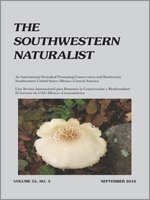I studied ecological relationships of 10 bobcats (Lynx rufus; 4 males, 6 females) from an unexploited population in the Chihuahuan Desert of southern New Mexico during 2004–2008. Using the 95% adaptive-kernel method, I estimated annual size of home ranges to be 12,887 ha for males and 2,847 ha for females. Average activity during nighttime and daytime was 80.6 and 18.8%, respectively. Desert cottontails (Sylvilagus audubonii) were the most common prey in scats. Annual rate of survival was 0.875 for males and 0.917 for females. Average weight of males and females was 12.6 and 9.0 kg, respectively. Two bobcats tested positive for toxoplasmosis. Compared to other areas, bobcats in my study area were heavier, there was more contrast between daytime and nighttime levels of activity, and males had larger home ranges. Rate of survival was similar to other unexploited populations.
How to translate text using browser tools
1 September 2010
Ecological Relationships of Bobcats (Lynx rufus) in the Chihuahuan Desert of New Mexico
Robert L. Harrison
ACCESS THE FULL ARTICLE

The Southwestern Naturalist
Vol. 55 • No. 3
September 2010
Vol. 55 • No. 3
September 2010




